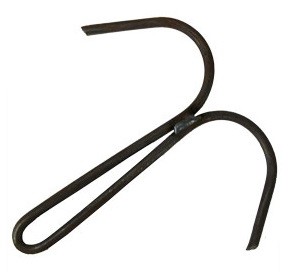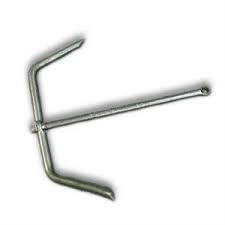This site is supported by you, the reader. If you make a purchase through one of my links, I may earn a small commission. Learn more here.
Drags are a great way to anchor traps for a number of reasons. Basically, instead of keeping a trap anchored where it’s set, a drag is designed to get hung up on brush, trees, and other objects while the caught animal leaves the set and heads for cover. It’s a great way to conceal your catch from other trappers, while allowing caught furbearers to get under cover and lower their stress level. Drags also allow trappers to make sets quickly without pounding in, or pulling out stakes. Drags aren’t perfect for every situation, and many times stakes are the way to go, but they certainly deserve a place on most trappers’ lines. Here’s an overview of trap drags on the market.
Drags for Wooded Country
 Standard 2-Prong Drag – The standard drags are the most basic, and usually the most affordable drags you can find. The drag is simply a piece of round steel bent in the shape of two letter J’s, with two sharpened points angled out in opposite directions. This is a decent drag to use in areas with lots of woods and thick brush, where there are plenty of opportunities for the drag to get hung up. You’ll still want to use plenty of chain to help increase the drag’s chance of hanging up. These drags don’t work well in open country. They are usually sold in two sizes: one for larger animals like coyotes and bobcats, and another for smaller animals.
Standard 2-Prong Drag – The standard drags are the most basic, and usually the most affordable drags you can find. The drag is simply a piece of round steel bent in the shape of two letter J’s, with two sharpened points angled out in opposite directions. This is a decent drag to use in areas with lots of woods and thick brush, where there are plenty of opportunities for the drag to get hung up. You’ll still want to use plenty of chain to help increase the drag’s chance of hanging up. These drags don’t work well in open country. They are usually sold in two sizes: one for larger animals like coyotes and bobcats, and another for smaller animals.
 Au Sable Rotating Trap Drag – PCS Outdoors has come up with an innovative new trap drag design with the Au Sable rotating trap drag. This drag is made up of two pieces of steel rod – a straight shaft and a cross piece with two sharpened points facing opposite directions. The only one of its kind, this drag is more effective at getting hung up due to the rotating nature of the pieces. While the standard drag would bounce off the ground, maintain its position and slide across the ground surface while being pulled, this one swivels when bounced, meaning one of the points will try digging down each time it makes contact. In addition, the built-in swivel helps keep the chain from binding up after the drag’s anchored. While they may not catch well in open ground, these are perfect drags for brushy and wooded ground. They are also lightweight, easy to bed, and sell at a surprisingly low price for what you get. These are sold in two sizes, with the smaller size made of 1/4″ steel rod, and the larger coyote size made of 3/8″.
Au Sable Rotating Trap Drag – PCS Outdoors has come up with an innovative new trap drag design with the Au Sable rotating trap drag. This drag is made up of two pieces of steel rod – a straight shaft and a cross piece with two sharpened points facing opposite directions. The only one of its kind, this drag is more effective at getting hung up due to the rotating nature of the pieces. While the standard drag would bounce off the ground, maintain its position and slide across the ground surface while being pulled, this one swivels when bounced, meaning one of the points will try digging down each time it makes contact. In addition, the built-in swivel helps keep the chain from binding up after the drag’s anchored. While they may not catch well in open ground, these are perfect drags for brushy and wooded ground. They are also lightweight, easy to bed, and sell at a surprisingly low price for what you get. These are sold in two sizes, with the smaller size made of 1/4″ steel rod, and the larger coyote size made of 3/8″.
Drags for Open Country
![]() For folks in open country, standard drags just don’t work. There isn’t much to get hung up on in open prairie or the high plains. But several innovators have decided it was still important to use drags in areas like these, especially when trapping certain areas and in times of high fur prices where thieves were more common. Legendary wolfer Eddie Wimberley designed the “High Plains Plow”, a super heavy duty drag that works great in open ground, but it’s hard to find these days. Craig O’Gorman sells a similar drag that’s very effective.
For folks in open country, standard drags just don’t work. There isn’t much to get hung up on in open prairie or the high plains. But several innovators have decided it was still important to use drags in areas like these, especially when trapping certain areas and in times of high fur prices where thieves were more common. Legendary wolfer Eddie Wimberley designed the “High Plains Plow”, a super heavy duty drag that works great in open ground, but it’s hard to find these days. Craig O’Gorman sells a similar drag that’s very effective.
J.C. Conner makes the “Tracker” series of drags. These are heavy duty drags designed for use in relatively open ground. The Freedom Brand Saber Tooth Drag is similar, made of heavy duty steel stock, lots of welded angles, a heavy overall weight, and sharp points to dig into the ground. The Freedom Brand Heavy Duty Drag is also a big bulky drag available at a lower price, but it’s made of rebar and doesn’t sport the sharp points that the Conner and Saber Tooth drags have. Minnesota Brand’s MB Trailblazer Drag is very similar to the Freedom Brand HD drag, and sold at a similar price. Kaatz Bros. sell a welded rebar drag too, without the frills, but at a lower price than most of the other heavy drags.
Hopefully this overview gives you a good idea of what’s out there for trap drags. If you have any questions or comments, give me a shout!
[…] in order to make sure the target animal doesn’t get away. Aside from the use of drags (click here for a revew on drags), this means fastening the trap to an immovable object. In the old mountain man days, the […]